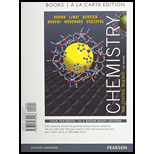
Concept explainers
(a)
To determine: A set of experiments or calculations to test the given hypotheses.
Concept Introduction: The replacement of the hydrogen atom by chlorine in the methyl group of the acetic acid increases the polarity of the
As the
(a)
Answer to Problem 1DE
Solution: Due to the presence of chlorine atom, the acidity of trichloroacetic acid is more than that of chloroacetic acid and acetic acid.
Explanation of Solution
The
Now, comparing the O-H bond polarity of all the three acids, since, chlorine is electronegative in nature, if it is attached to the carbonyl carbon, the polarity of O-H bond increases, the O-H bond become weak making the compound more acidic.
Due to the presence of 3 chlorine atoms, trichloroacetic acid is more acidic than the chloroacetic acid which is then more acidic than acetic acid.
The
It is mathematically represented as follows:
Here,
Taking example of dissociation of acetic acid, the reaction will be as follows:
The expression for acid dissociation constant can be written as follows:
More the value of
The solution of the known concentration of the acetic acid, chloroacetic acid and trichloroacetic acid in different flask and the
The concentration of the proton ion is calculated by the formula:
The concentration of the proton is same as that of the conjugate base of the acids. Also the concentrations of the acids are known.
Thus, the equilibrium concentration of the acid is calculated by the formula:
Hence, using the
The
(b)
To determine: An experiment to determine the solubility of acetic acid, chloroacetic acid and trichloroacetic acid.
(b)
Answer to Problem 1DE
Solution: As the value of
Explanation of Solution
The solubility of any salt depends on its concentration, which is related to pH and
The above equation is Henderson-Hasselbach equation.
From the above equation, if the pH of solution decreases, the acid concentration increases and that of salt decreases.
Since, the acidity of acetic acid is least thus, its solution has maximum pH value and its sodium salt has maximum solubility.
The trichloroacetic acid is strongest acid and has minimum pH thus, its sodium salt has minimum solubility.
As the value of
Want to see more full solutions like this?
Chapter 17 Solutions
Chemistry: The Central Science, Books a la Carte Edition & Modified Mastering Chemistry with Pearson eText -- ValuePack Access Card Package
- In GC, what order will the following molecules elute from the column? CH3OCH3, CH3CH2OH, C3H8, C4H10arrow_forwardBeer’s Law is A = εbc, where A is absorbance, ε is the molar absorptivity (which is specific to the compound and wavelength in the measurement), and c is concentration. The absorbance of a 2.31 × 10-5 M solution of a compound is 0.822 at a wavelength of 266 nm in a 1.00-cm cell. Calculate the molar absorptivity at 266 nm.arrow_forwardHow to calculate % of unknown solution using line of best fit y=0.1227x + 0.0292 (y=2.244)arrow_forward
- Given a 1,3-dicarbonyl compound, state the (condensed) formula of the compound obtaineda) if I add hydroxylamine (NH2OH) to give an isooxazole.b) if I add thiosemicarbazide (NH2-CO-NH-NH2) to give an isothiazole.arrow_forwardComplete the following acid-base reactions and predict the direction of equilibrium for each. Justify your prediction by citing pK values for the acid and conjugate acid in each equilibrium. (a) (b) NHs (c) O₂N NH NH OH H₁PO₁arrow_forward23.34 Show how to convert each starting material into isobutylamine in good yield. ཅ ནད ཀྱི (b) Br OEt (c) (d) (e) (f) Harrow_forward
- Please help me Please use https://app.molview.com/ to draw this. I tried, but I couldn't figure out how to do it.arrow_forwardPropose a synthesis of 1-butanamine from the following: (a) a chloroalkane of three carbons (b) a chloroalkane of four carbonsarrow_forwardSelect the stronger base from each pair of compounds. (a) H₂CNH₂ or EtzN (b) CI or NH2 NH2 (c) .Q or EtzN (d) or (e) N or (f) H or Harrow_forward
- 4. Provide a clear arrow-pushing mechanism for each of the following reactions. Do not skip proton transfers, do not combine steps, and make sure your arrows are clear enough to be interpreted without ambiguity. a. 2. 1. LDA 3. H3O+ HOarrow_forwardb. H3C CH3 H3O+ ✓ H OHarrow_forward2. Provide reagents/conditions to accomplish the following syntheses. More than one step is required in some cases. a. CH3arrow_forward
 ChemistryChemistryISBN:9781305957404Author:Steven S. Zumdahl, Susan A. Zumdahl, Donald J. DeCostePublisher:Cengage Learning
ChemistryChemistryISBN:9781305957404Author:Steven S. Zumdahl, Susan A. Zumdahl, Donald J. DeCostePublisher:Cengage Learning ChemistryChemistryISBN:9781259911156Author:Raymond Chang Dr., Jason Overby ProfessorPublisher:McGraw-Hill Education
ChemistryChemistryISBN:9781259911156Author:Raymond Chang Dr., Jason Overby ProfessorPublisher:McGraw-Hill Education Principles of Instrumental AnalysisChemistryISBN:9781305577213Author:Douglas A. Skoog, F. James Holler, Stanley R. CrouchPublisher:Cengage Learning
Principles of Instrumental AnalysisChemistryISBN:9781305577213Author:Douglas A. Skoog, F. James Holler, Stanley R. CrouchPublisher:Cengage Learning Organic ChemistryChemistryISBN:9780078021558Author:Janice Gorzynski Smith Dr.Publisher:McGraw-Hill Education
Organic ChemistryChemistryISBN:9780078021558Author:Janice Gorzynski Smith Dr.Publisher:McGraw-Hill Education Chemistry: Principles and ReactionsChemistryISBN:9781305079373Author:William L. Masterton, Cecile N. HurleyPublisher:Cengage Learning
Chemistry: Principles and ReactionsChemistryISBN:9781305079373Author:William L. Masterton, Cecile N. HurleyPublisher:Cengage Learning Elementary Principles of Chemical Processes, Bind...ChemistryISBN:9781118431221Author:Richard M. Felder, Ronald W. Rousseau, Lisa G. BullardPublisher:WILEY
Elementary Principles of Chemical Processes, Bind...ChemistryISBN:9781118431221Author:Richard M. Felder, Ronald W. Rousseau, Lisa G. BullardPublisher:WILEY





